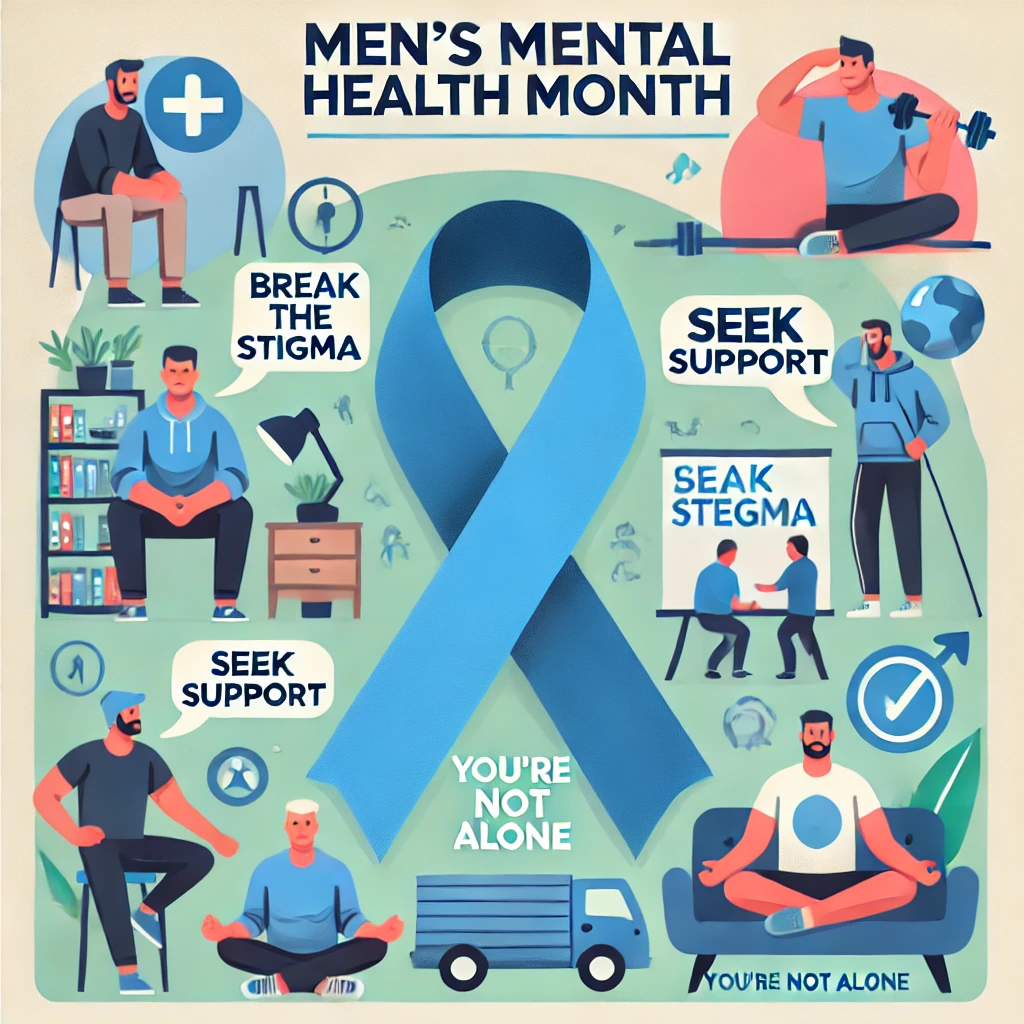Men’s mental health month
Men’s mental health month. We’re discussing mental health more now than we ever have before. People are becoming more open about their mental health, and we’re all learning better ways to support each other.
But people may often underreport men’s mental health, with men not reaching out for the support they need. And that’s where Men’s Mental Health Awareness Month comes in, bringing attention to men’s mental health.

For everything you need to know about Men’s Mental Health Awareness Month, from when it is to how to show your support, just keep reading.
When is Men’s Mental Health Awareness Month?
Mental Health America (MHA) recognizes June as Men’s Mental Health Awareness Month, as does the International Men’s Health Month website.
But it’s worth remembering that not every country recognizes June as Men’s Mental Health Awareness Month. For example, November is Men’s Mental Health Awareness Month in the United Kingdom. It’s also known as November, as men grow mustaches to raise awareness of men’s health conditions. These include mental health conditions but also conditions like prostate and testicular cancer.
What color ribbon do people use to support men’s mental health?
Some people use green ribbons to support men’s mental health each June, but you can wear them throughout the year.
How to support Men’s Mental Health Awareness Month
If you’d like to support Men’s Mental Health Awareness Month, you could do it in many ways. You might hold an event to raise awareness and money for a mental health charity or organization. You could raise money through a garage sale or bake sale, get people to sponsor you in a race or a competition, or reach out to your workplace or your child’s school to see whether there’s anything they could do to raise awareness.
There are a lot of charities, organizations, and groups out there that do important work around men’s mental health and mental health more generally. Men’s mental health organizations in the United States and abroad include:
- Face It
- MenLiving
- Heads Up Guys
- Next Gen Men
- Campaign Against Living Miserably
MHA, the National Institute of Mental Health, the American Foundation for Suicide Prevention, and the National Alliance on Mental Illness don’t focus solely on men’s mental health but are worth supporting ― and they’re useful resources if you’d like to learn more.

It’s also important to listen to the men in your life if they reach out to you and let them know that you’re there. Of course, this isn’t limited solely to Men’s Mental Health Awareness Month ― men’s mental health remains a big concern throughout the year, not just in June.
Understanding men’s mental health concerns
There’s still a stigma around men’s mental health, making it more difficult for men and boys to reach out for help. Some men might still feel as if people expect them to hide their emotions and “man up,” or be strong for others. Having or acknowledging a mental health condition is still seen as a sign of weakness or lack of masculinity among some men.
But mental health conditions aren’t signs of personal weakness ― they’re health conditions just like any other. You wouldn’t feel shame about getting a doctor’s help with a broken arm, and contacting a therapist isn’t any different.
Disruptive Behavioral Disorders
Behavioral disorders involve a pattern of disruptive behaviors in children that last for at least 6 months and cause problems in school, at home, and in social situations. Behavioral symptoms can also continue into adulthood, with the disruptive behaviors becoming impulsive to the point of serious self detriment.
Mood Disorders Such as Depression and Bipolar disorders
While bad moods are common, and usually pass in a short period, people suffering from mood disorders live with more constant and severe symptoms. Their mood impacts both mental and psychological well-being, nearly every day. 1 in 10 adults suffer from some type of mood disorder, with the most common conditions being depression and bipolar disorder. If left untreated, this illness can affect role functioning, quality of life and many long-lasting physical health problems such as diabetes and heart disease. With proper diagnosis and treatment, most of those living with mood disorders lead healthy, normal and productive lives. Many go undiagnosed, making mental health awareness a social imperative.
Eating Disorders
Eating disorders involve obsessive and sometimes distressing thoughts and behaviors concerning food and/or body image, including: • Reduction of food intake
- Overeating
- Feelings of depression or distress
- Concerns or delusions about weight, body shape, poor self-image (Body Dysmorphia)
Common types of eating disorders include anorexia, bulimia, and binge eating.
Personality Disorders
People with personality disorders have extreme and inflexible personality traits that cause problems in work, school, or social relationships. Sharp and sudden personality changes can also be present. Personality disorders include antisocial personality disorder and borderline personality disorder (BPD).
Posttraumatic Stress Disorder (PTSD)
PTSD can manifest after living through a traumatic event, such as war, a natural disaster, abuse, or a serious accident. PTSD can make someone feel stressed and afraid after the danger is over. People with PTSD may experience symptoms like reliving the traumatic event, sleep problems, suffer from panic attacks, paranoia, and changes in emotions. PTSD can cause irritability, emotional outbursts, helplessness, or feelings of numbness.
Schizophrenia Spectrum and Other Psychotic Disorders
People with psychotic disorders hear, see, and believe things that aren’t real or true. They may also show signs of disorganized thinking, confused speech, and abnormal motor behavior. An example of a psychotic disorder is schizophrenia, which can also present disorganized motivation and emotions.
June is Men’s Health Awareness Month
Be Mindful of Your Mental Health
June is National Men’s Health Month, the perfect time to be aware and open about a subject that many guys would rather not talk about. Yet, that’s precisely why there is a silent epidemic in this country, and it’s probably impacting your family, co-workers, teachers, community members or friends. We’re talking about men’s mental health.
Rates of male depression and suicide have risen dramatically in recent years. According to the American Foundation for Suicide Prevention, men are almost four times more likely to die by suicide than women, and more than 6 million men in the U.S. experience symptoms of depression every year. Despite these sobering statistics, a recent survey revealed that 49% of men felt more depressed than they admitted to the people in their lives. Perceptions of weakness about requiring therapy, fears of social disapproval and cultural factors are some of the main barriers inhibiting men from seeking mental health assistance.
Men with depression often aren’t diagnosed for several reasons, including:
- Failure to recognize depression.
- Downplaying signs and symptoms.
- Reluctance to discuss depression symptoms.
- Resisting mental health treatment.
Notice the warning signs of depression. According to Families for Depression Awareness, signs of adult depression – which are changes from how the person usually is – may include:
- Talking very negatively or expressing hopelessness.
- Acting without concern for others.
- Abusing alcohol or drugs.
- Withdrawing from family and friends.
- Problems concentrating, making decisions or remembering.
- Talking suddenly about separation or divorce.
- Complaining of physical aches and pains.
- Eating too little or too much.
- Sleeping too much or too little.
Risks for Men
There are a number of factors that can put men at increased risk for mental health problems, including:
- Toxic masculinity: Traditional gender roles often dictate that men should be strong, silent, and self-sufficient. This can make it difficult for men to express their emotions and seek help when they need it.
- Work stress: Men are more likely to be employed in high-stress jobs, and they are also more likely to work long hours. This can lead to burnout, depression, and anxiety.
- Financial problems: Men are more likely to be the primary breadwinners for their families, and they are also more likely to be unemployed. This can lead to financial stress, which can also trigger mental health problems.
- Substance abuse: Men are more likely to abuse alcohol and drugs, which can worsen mental health problems.
June is Men’s Health Month
During the month of June men and boys are encouraged to take charge of their health. Get screened, eat a healthy meal, exercise, get outdoors and check in with a friend. Use this month to set good habits in motion, and carry them throughout the year. There are a variety of websites with resources full of everything from healthy recipes to exercise tips to mental health pod casts as well as testicular and prostate cancer checks. Check them out. Find what works for you and get started today.
Canadian Men’s Health Foundation
The Canadian Men’s Health Foundation is a national, registered charity providing information, tools, and motivation for men and their families to live healthier. Canadian men are dying at an alarming rate from chronic illness and leaving their loved ones behind. Yet, 70% of men’s health problems are preventable by living healthier. No matter how you do it—walk, jog, swim, bike, or mow the lawn—any kind of movement adds up to better physical and mental health. Sign up for a ‘Guy’s guide to eating healthy‘ or listen to the Don’t change much pod cast.




